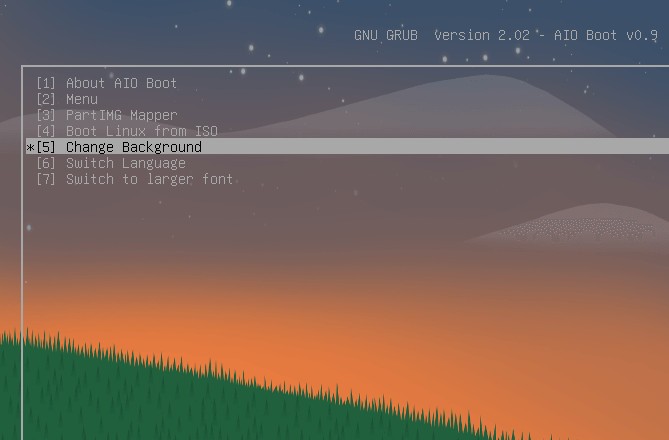AIO Boot uses the Grub2 default theme for the fastest boot speed. Instead, you can change the background, language, and font size of Grub2.
Introduction
AIO Boot has used the default theme of Grub2 since its initial release. It is quite nice, lightweight and of course is best suited for Grub2. AIO Boot has too many menus, and it has hotkeys support for quick access to a menu, the hotkey is in square brackets. This helps you to quickly boot into the operating system.
There are two ways that you can change the background, language, and font for the AIO Boot’s Grub2. Run AIOCreator.exe and change it in Settings, or boot into Grub2 and change it in the Help menu (press the z key). In this article I will share the Grub2 scripts I wrote for AIO Boot.
After changing the background image, language and font for Grub2, these values are saved. In the code below, I will use the save_env command to save the bg, lang and font variables to the grubenv file. If you have not run AIOCreator.exe yet, rename /AIO/grub/_grubenv to /AIO/grub/grubenv. When booting into Grub2, you just need to check the value of these variables. If so then use, otherwise set by default.
Background image
To display the background image for Grub2, just use the background_image command.
background_image "/AIO/grub/themes/splash.png"
By default, the wallpaper will be made to fit the screen resolution. If you want to keep the size of the background image, add a “normal” value for the “-m” parameter.
background_image -m normal "/AIO/grub/themes/splash.png"
This is the Grub2 script to change the background image.
submenu "Change Background" {
insmod regexp
echo "Getting the list of files in \"/AIO/grub/themes\". Please wait..."
for file in /AIO/grub/themes/*; do
if ! test -f "$file"; then continue; fi
if [ "$file" == "/AIO/grub/themes/${bg}" ]; then continue; fi
regexp -s filename "/AIO/grub/themes/(.*)" "$file"
if [ -z "$havefile" ]; then set havefile="1"; fi
menuentry "${filename}" {
bg="$1"
background_image "${prefix}/themes/${bg}"
save_env bg
configfile ${prefix}/grub.cfg
}
done
if [ -z "$havefile" ]; then
esccont "Please copy all your PNG, JPG and JPEG files to the \"/AIO/grub/themes\" folder."
else
unset havefile
menuentry "Return to the Main menu" {
configfile ${prefix}/grub.cfg
}
fi
unset filename
}When you access the above menu, it will list all the files in the /AIO /grub/themes directory (except for the current background image). Then choose one of those files as the background image for Grub2. If the background image not showing, its size may not fit. You also need to load the necessary modules first, jpeg for .JPG and .JPEG, png for .PNG.
insmod jpeg insmod png
Languages
Grub2 supports 38 languages. Grub2 language files are located in the locale directory. Here is a Grub2 script that shows 37 languages (except for the current language), just select one of the menus to change the language.
submenu "Change Language" {
insmod regexp
for langstr in "vi=Tiếng Việt" "en=English" "ast=Asturian; Bable; Leonese; Asturleonese" "ca=català" "zh_CN=中文 (Simplified)" "zh_TW=中文 (Traditional)" "da=dansk" "nl=Dutch" "en@arabic=English - Arabic" \
"en@cyrillic=English - Cyrillic" "en@greek=English - Greek" "en@hebrew=English - Hebrew" "en@piglatin=English - Piglatin" "en@quot=English - Quot" \
"eo=Esperanto" "fi=Finnish" "fr=français" "gl=Galego" "de=Deutsch" "de@hebrew=German - Hebrew" "de_CH=German - SWITZERLAND (CH)" "hu=magyar" \
"hr=hrvatski jezik" "id=Bahasa Indonesia" "it=Italiano" "ja=日本語" "lt=lietuvių kalba" "nb=Norsk Bokmål" "no=Norwegian" "pl=Polish" "pt_BR=Português" "pa=Panjabi" "ru=русский" "sr=српски језик" \
"sl=Slovenian" "es=Español" "sv=Svenska" "tr=Türkçe" "uk=Українська"; do
regexp -s 2:langname -s 1:langcode '(.*)=(.*)' "$langstr"
if [ "$langcode" == "$lang" ] -o [ -z "$lang" -a "$langcode" == "en" ] -o [ "$langcode" != "en" -a ! -e /AIO/grub/locale/${langcode}.mo ]; then continue; fi
menuentry "${langname}" "$langcode" {
lang="$2"
save_env lang
configfile ${prefix}/grub.cfg
}
done
menuentry "Return to the Main menu" {
configfile ${prefix}/grub.cfg
}
}If the Grub2 language file does not exist, the language will not be listed.
Fonts
AIO Boot uses Unicode fonts (unicode.pf2) to support all 38 languages. Available in two sizes, Small and Large, for the English language, AIO Boot uses DejaVuSansMono fonts for large sizes.
if [ "$font" == "unicode-small" ]; then fontmenu="Switch to larger font"; else fontmenu="Switch to smaller font"; fi
menuentry "${fontmenu}" {
if [ "$font" != "unicode-small" ]; then font=unicode-small;
elif [ -z "$lang" ]; then font=DejaVuSansMono-large; else font=unicode-large; fi
save_env font
configfile ${prefix}/grub.cfg
}Use the grub-mkfont command to create font files for Grub2.
You may need to modify and improve the Grub2 code before using it. Leave a comment if you have any questions.


Hello,
any way to use a custom theme or edit more than background, language and font?
by the way, thanks for AIO, great stuff!
You do not say what size wallpaper it needs to be ?
Hi
I want support your product
And translate your software into Arabic
If not translated to Arabic
If the program needs to update the Arabic translation
If supports multiple languages
and UTF-8 encoding
I think at the moment it does not matter changing the user interface to “right to left” because there is a lot of work out there.
I hope accepting my invitation with the full support for your software
please replay with agree or disagree,
we don’t take money
Also Please write the program name and download link
Sender
MFM Dawdeh
Yes, of course I would like this program to be translated into many languages to serve users.
The program supports UTF-8 encoding including Vietnamese and many other languages.
Send me a translation if you would like to help us.
I’m sorry
Have you received the translation or not?
After adding the Arabic language, it is necessary to make sure that the status and appearance of the program
Thank you, I received the translation. But the translation is not complete.